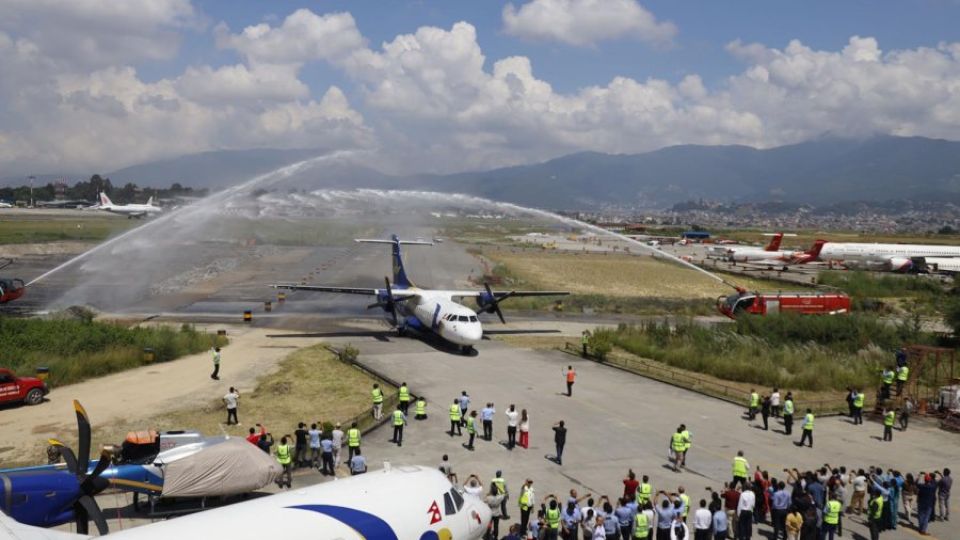September 12, 2024
KATHMANDU – After 29 years in the skies, an ATR 42-320, a twin-turboprop with the Nepali registration mark 9N-AIN, took its final flight on Tuesday. It left the Kathmandu airport with nearly a dozen and a half people onboard on a sightseeing tour, popularly known as mountain flight. After landing, the retirement was announced at the hangar of Buddha Air, its owner.
This marks the first time an ATR aircraft has been retired after completing its full commercial service cycle and the first time any aircraft has been retired from active service in Nepal’s 70-year aviation history.
An official ceremony was held at Buddha Air’s hangar at the Kathmandu airport. After its last commercial flight, the venerable aircraft was honoured with a water cannon salute.
Birendra Bahadur Basnet, the chairman of Buddha Air, Nepal’s largest private airline, was visibly moved by the occasion.
“This is one of the most heartfelt moments I’ve experienced!” said Basnet.
“This marks a significant milestone for Buddha Air and the global ATR Fleet family, as this is the first ATR aircraft to complete its full economic cycle,” said Basnet.
“The relentless work of the technical and operations teams at Buddha Air has made it possible to complete the full flight cycle safely and efficiently. This achievement reflects the airline’s commitment to aircraft maintenance and operational safety.”
The ATR 42 (manufacturer serial number 403), a twin-engine turboprop, short-haul regional airliner developed and produced in France and Italy by aircraft manufacturer ATR, rolled off the production line and made its first flight in August 1995. The “42” in its name refers to the aircraft’s standard seating capacity, which ranges from 40 to 52 passengers.
It entered commercial service for Pacific carrier Air Caledonie in November 1997.
The airline returned the aircraft to its lessor, ATR, in November 2007.
Over the years, the ATR clocked a full economic life with 70,000 cycles, including 44,477 flights for Buddha Air.
That’s a whopping 23,032 hours of flying time in the Nepali skies in the last 16 years, carrying a total of 1.8 million passengers.
“The final flight was on Tuesday. It retired with the last mountain flight,” said Mangesh Thapa, chief engineer at Buddha Air.
“Every aircraft has designated flight cycles based on the manufacturer’s guidelines and model set by the manufacturing company. While aircraft don’t have an age limit, their life span is based on their flight cycles. This ATR’s retirement follows the scheduled cycle-based decommissioning.”
A flight cycle consists of one take-off and one landing.
According to Thapa, its parts would be stripped for reuse. “We plan to donate the fuselage of the venerable aircraft to the Civil Aviation Authority of Nepal, which can be used for holding drills.”
According to the International Air Transport Association (IATA), around 16,000 commercial passenger and cargo aircraft have been retired worldwide in the last 35 years with 11,000 more retirements expected over the next decade.
Between 2010 and 2014 alone, 700 to 900 aircraft were retired annually, with an average age of around 27 years. But the lifecycle alone may not be the only reason for retiring an aircraft. Factors like fuel efficiency and new technology, among other things, can also speed up their retirement. According to aviation experts, it is rare for a plane to complete its full economic cycle before being retired.
The ATR is a product of the French company Aérospatiale and the Italian conglomerate Aeritalia, with final assembly taking place in Toulouse, France.
In 1981, Aérospatiale and Aeritalia signed a cooperation agreement and merged their concept designs to create the ATR 42.
The aircraft’s first flight took place in August 1984, and by September 1985, it received certification from French and Italian aviation authorities.
In January 1986, ATR announced the development of an enlarged version, the ATR 72.
“This mountain flight was spectacular,” said Elsa Calley, chargé d’affaires of the French Embassy in Nepal, one of the passengers on Tuesday’s last flight. “It’s an honour to stand before you today on this significant occasion as we bid farewell to Buddha Air’s ATR 42 in such a well-maintained venue [hangar].”
Buddha Air started operation on October 11, 1997, with one Beechcraft 1900D. Since the introduction of its first two ATR 42-320 in 2008, the carrier has expanded its fleet to 18 ATR aircraft, making it the seventh-largest ATR fleet operator in the world.
The airline continues to strengthen its position in the Nepali aviation sector, holding over 60 percent of the passenger market share. Buddha was ATR’s second customer in Nepal.
In 2023, Nepal’s domestic airline companies flew 4.15 million passengers. Buddha Air recorded a steep 7.94 percent growth in passenger numbers last year, compared to 2022, flying 2.57 million passengers.
Before Buddha Air’s rise, Nepal’s first private airline, Necon Air, was established in 1992 when the country adopted the liberal sky policy. It had introduced the popular ATR 42 aircraft into the national aviation market.


